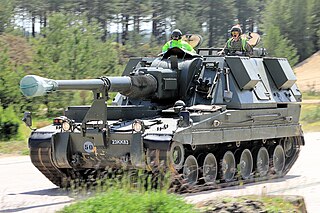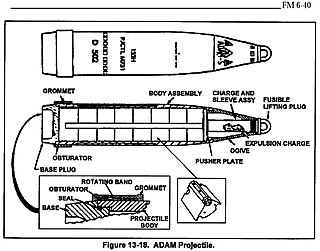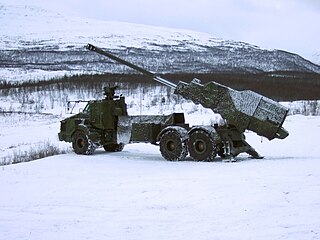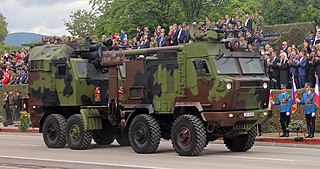
The M198 is a medium-sized, towed 155 mm artillery piece, developed for service with the United States Army and Marine Corps. It was commissioned to be a replacement for the World War II-era M114 155 mm howitzer. It was designed and prototyped at the Rock Island Arsenal in 1969 with firing tests beginning in 1970 and went into full production there in 1978. It entered service in 1979 and since then 1,600 units have been produced.

The M109 is an American 155 mm turreted self-propelled howitzer, first introduced in the early 1960s to replace the M44. It has been upgraded a number of times, most recently to the M109A7. The M109 family is the most common Western indirect-fire support weapon of maneuver brigades of armored and mechanized infantry divisions.

The 8 inch (203 mm) M110 self-propelled howitzer is an American self-propelled artillery system consisting of an M115 203 mm howitzer installed on a purpose-built chassis. Before its retirement from US service, it was the largest available self-propelled howitzer in the United States Army's inventory; it continues in service with the armed forces of other countries, to which it was exported. Missions include general support, counter-battery fire, and suppression of enemy air defense systems.

The AS-90, known officially as Gun Equipment 155 mm L131, is an armoured self-propelled artillery used by the British Army.

The 2S1 Gvozdika is a Soviet self-propelled howitzer introduced in 1972 and in service in Russia and other countries as of 2023. It is based on the MT-LBu multi-purpose chassis, mounting a 122 mm 2A18 howitzer. "2S1" is its GRAU designation. An alternative Russian designation is SAU-122, but in the Russian Army it is commonly known as Gvozdika. The 2S1 is fully amphibious with very little preparation, and once afloat is propelled by its tracks. A variety of track widths are available to allow the 2S1 to operate in snow or swamp conditions. It is NBC protected and has infrared night-vision capability.

The M777 howitzer is a towed 155 mm artillery piece in the howitzer class. It is used by the ground forces of Australia, Canada, Colombia, India, Saudi Arabia, Ukraine, and the United States. It was first used in combat during the War in Afghanistan.

A dual-purpose improved conventional munition (DPICM) is an artillery or surface-to-surface missile warhead designed to burst into submunitions at an optimum altitude and distance from the desired target for dense area coverage. The submunitions use both shaped charges for the anti-armor role, and fragmentation for the antipersonnel role, hence the nomenclature "dual-purpose". Some submunitions may be designed for delayed reaction or mobility denial (mines). The air-to-surface variety of this kind of munition is better known as a cluster bomb. They are banned by more than 100 countries under the Convention on Cluster Munitions.

The M982 Excalibur is a 155 mm extended-range guided artillery shell developed in a collaborative effort between the U.S. Army Research Laboratory (ARL) and the United States Army Armament Research, Development and Engineering Center (ARDEC). The Excalibur was developed and/or manufactured by prime contractor Raytheon Missiles & Defense, BAE Systems AB and other subs and primes in multiple capacities such as Camber Corporation and Huntington Ingalls Industries. It is a GPS and inertial-guided munition capable of being used in close support situations within 75–150 meters (250–490 ft) of friendly troops or in situations where targets might be prohibitively close to civilians to attack with conventional unguided artillery fire. In 2015, the United States planned to procure 7,474 rounds with a FY 2015 total program cost of US$1.9341 billion at an average cost of US$258,777 per unit. By 2016, unit costs were reduced to US$68,000 per round. Versions that add laser-guidance capability and are designed to be fired from naval guns began testing in 2015. By October 2018, over 1,400 rounds had been fired in combat.

Area denial artillery munition (ADAM) is a family of United States land mines and 155 mm artillery projectiles.

The SO-152, usually known by its GRAU designation 2S3, is a Soviet 152.4 mm self-propelled gun developed in 1968, as a response to the American 155 mm M109 howitzer. Development began in 1967, according to the Resolution of the Council of Ministers of the Soviet Union from July 4, 1967. In 1968, the SO-152 was completed and in 1971 entered service. The fighting vehicle also received the added designation Akatsiya (Акация), which is Russian for Acacia.

The Archer Artillery System, or Archer – FH77BW L52, or Artillerisystem 08, is a Swedish self-propelled howitzer system. The main piece of the system is a fully automated 155 mm L52 (52-calibre-long) gun-howitzer and a M151 Protector remote-controlled weapon station mounted on a modified 6×6 chassis of the Volvo A30D all-terrain articulated hauler. The crew and engine compartment is armoured and the cab is fitted with bullet and fragmentation-resistant windows. The system also includes an ammunition resupply vehicle, a support vehicle, BONUS submunitions, and M982 Excalibur guided projectiles.

The Nora B-52 is a 155 mm self-propelled howitzer developed by Military Technical Institute and manufactured by Yugoimport SDPR in Velika Plana, Serbia.

The 2K25 Krasnopol is a Soviet 152/155 mm cannon-launched, fin-stabilized, base bleed-assisted, semi-automatic laser-guided artillery weapon system. It automatically 'homes' on a point illuminated by a laser designator, typically operated by a drone or ground-based artillery observer. Krasnopol projectiles are fired mainly from Soviet self-propelled howitzers such as the 2S3 Akatsiya and 2S19 Msta-S and are intended to engage small ground targets such as tanks, other direct fire weapons, strong-points, or other significant point targets visible to the observer. It can be used against both stationary and moving targets.

The KS-19 100mm anti-aircraft gun is a Soviet anti-aircraft gun that also features good capabilities against ground targets.

The Rocket Forces and Artillery of the Ukrainian Ground Forces consist of units armed with tactical missiles, howitzers, cannons, mortars, jet-propelled and anti-tank artillery. They are tasked to destroy human resources, tanks, artillery, anti-tank weapons, aircraft, air defense and other important installations operations.

155 mm is a NATO-standard artillery shell caliber that is used in many field guns, howitzers, and gun-howitzers. It is defined in AOP-29 part 1 with reference to STANAG 4425.
Family of Scatterable Mines (FASCAM) is an umbrella term for a range of systems of the armed forces of the United States, which allows a maneuver commander to rapidly place mines as a situational obstacle; as a reserve obstacle emplacement capability; and to directly attack enemy formations through disrupt, fix, turn, and block. Modern fusing, sensing, and anti-disturbance devices allow scatterable mines to defeat enemy attempts to reduce and/or clear the minefield. FASCAM mines are delivered through artillery, rocket launchers, indirect crew served weapons, special mine sowing vehicles, helicopters and aircraft. FASCAM mines utilize a random or pre-programmed self-destruct period, countermeasure hardening and anti-disturbance features. All FASCAM mines have an active life cycle and self-destruct (SD) time after their active life has expired. The duration of the active life varies from 4 hours to 15 days depending on the system.

The Enigma is an 8×8 wheeled amphibious armored personnel carrier developed by Emirates Defense Technology in UAE. It was introduced at IDEX 2015.

The M1299 was an American prototype 155 mm self-propelled howitzer developed by BAE Systems beginning in 2019 under the Extended Range Cannon Artillery (ERCA) program. It was based on the M109A7 howitzer and was primarily designed for the purpose of improving the M109's effective range. The program was canceled in 2024.
On 24 February 2022, Russia invaded Ukraine, escalating the Donbas War that began in 2014 into the Russo-Ukrainian War. Twenty-one months later, on 20 November 2023, Ukraine had cumulatively received over $44 billion in materiel aid from the United States and over $35 billion from other allies on a month-to-month basis. The aid is logistical and is provided by drawdown of existing materiel that is then delivered to Ukraine. As this materiel is expended, the allied industrial base has been gradually drawn in to supply Ukraine but had not been fully engaged as of November 2023.


















